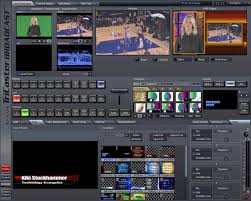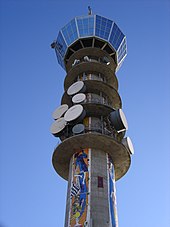BILQIS TV
insyaaalah blessing, supporting shariah, the
voice of truth,
Most commercial television stations broadcasting companies that are arranged in a variety of ways to generate revenue from television advertising. They may be an independent station or part of a broadcast network, or some other structure. They can produce some or all of their programs or buy some broadcast programs or syndicated to all of the other stations or independent production companies.
Many stations have some sort of television studio, which was a major network stations used to broadcast news or other local programming. Usually there is a news department, where journalists gather information. There is also a section in which the electronic news-gathering (ENG) operations are based, receiving remote broadcasts via remote pickup unit or satellite TV. Outside broadcast vans, production trucks, or SUVs with electronic field production equipment (SPE) is sent out to the press, which can also bring back the news on video tape instead of sending them back to life.
To keep pace with technology United States television stations have replaced the operator with broadcast automation systems to increase profits in recent years.
BILQIS
TV
Stations not affiliated with major television networks generally do not air to the public, or many other television programs. Some stations (known as repeaters or translators) only simulcast another, usually seen on the station's flagship program owners, and do not have a television studio or production facilities of their own. This is common in developing countries. Low-power stations are usually also included in this category worldwide.
Most stations are not simulcast produce their own station identification, using digital graphic alien TV. TV stations can also advertise on or provide weather (or news) services to local radio stations, notably co-owned sister station. This may barter in some cases.
BILQIS TV
insyaaalah blessing, supporting shariah, the
voice of truth,
The television station is a business entity, or other organization, such as the operator (ATV) amateur television, which transmits (broadcasts) content over terrestrial television. A television transmission can occur through analog television signals or, recently, by digital television signals. Television system standards set by the government, and these vary across the world. Television stations broadcasting via the anolog are usually limited to one television channel, but digital television allows broadcasters via subchannels as well. The "TV station" The term is usually applied to terrestrial television stations, and not to cable or satellite broadcasts.

Television stations usually require a broadcast license from a government agency that sets requirements and restrictions station. In the United States, for example, defines a television license broadcast range, or geographic area, the station is limited, allocating broadcast frequencies of the radio spectrum for transmitting the station, setting limits on what kind of program can be programmed to broadcast television, and requires stations to broadcast a minimum amount certain types of programs, such as public affairs messages, among others.

Most commercial television station independently owned, but many are either affiliated with or television network owned-and-operated (O & O) by the television networks. Another form of a television station can take is a non-commercial educational (NCE) and public broadcasters consider. To avoid concentration of media ownership of television stations, government regulations in most countries generally restrict ownership of television stations with television networks and other media operators, but the rules vary. Some countries have set up national television networks, in which individual television stations act as repeaters only national program. In these countries, the local television station has no station identification and, from the point of view of the consumer, there is no practical difference between the networks and stations, with only small changes in the areas of programming, such as local television news.
BILQIS TV
insyaaalah blessing, supporting shariah, the
voice of truth,
The radio station is just beginning radiotelegraphy system and does not carry audio. The first claimed audio transmission that could be called a broadcast occurred on Christmas Eve in 1906, and was made by Reginald Fessenden. Is this broadcast actually happened is debatable. While early researchers who seek to create a system similar to radiotelephone devices where only two parties were meant to communicate, there were others who intended to transmit to larger audiences.
BILQIS TV
insyaaalah blessing, supporting shariah, the
voice of truth,
Charles Herrold started broadcasting in California in 1909 and brings audio by the next year. (Herrold station that eventually became KCBS).
Over the next decade, radio tinkerers had to build their own radio receivers. In Den Haag, the Netherlands, PCGG started broadcasting on November 6, 1919. In 1916, Frank Conrad, an employee for the Westinghouse Electric Corporation, from broadcasts, Wilkinsburg Pennsylvania garage with the call letters 8XK. Later, the station was moved to the top of the Westinghouse factory building in East Pittsburgh, Pennsylvania. Westinghouse relaunched the station as KDKA on November 2, 1920, claiming to be the "world's first commercially licensed radio station". Commercial broadcasting designation came from the type of broadcast license, ad did not air until years later. The first licensed broadcast in the United States came from KDKA itself: the results of elections Harding / Cox Presidential. Montreal station that became CFCF began broadcast programming on May 20, 1920 and the Detroit station that became WWJ began broadcasting a program that began on August 20, 1920, though not held a license at the time.
Radio Argentina began regularly scheduled transmissions from the Teatro Coliseo in Buenos Aires on August 27, 1920, making its own priority claim. Station received permission on 19 November 1923. The delay is due to a lack of official Argentine licensing procedures before that date. This station continued regular broadcasting of entertainment and cultural fare for several decades.
Radio in education soon followed and colleges across the U.S. began adding radio broadcasting courses to their curricula. Curry College in Milton, Massachusetts introduced one of the first broadcasting majors in 1932 when the college worked with WLOE in Boston to have students broadcast programs.
